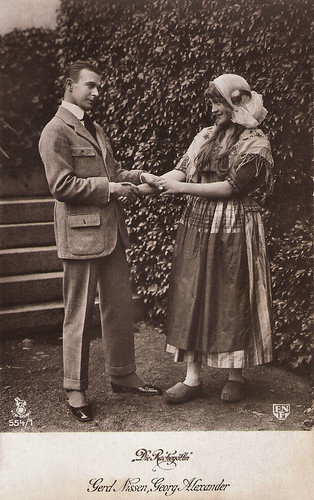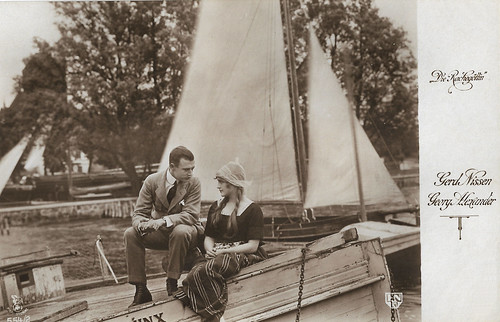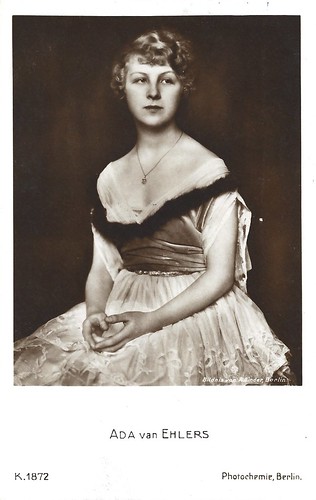
German postcard by Verlag Hermann Leiser, Berlin, no. 7477. Gerd Egede-Nissen.

German postcard by Verlag Hermann Leiser, no. 5069. Photo: B.J.G. Ada van Ehlers.
Gerd Egede-Nissen
Gerd Egede-Nissen, later Gerd Grieg was born in 1895 in Bergen, Norway. Gerd was the daughter of NKP leader Adam Egede-Nissen and Goggi Egede-Nissen. She was the sister of actors Aud Richter (née Aud Egede-Nissen), Ada Kramm (née Ada Egede-Nissen), Oscar Egede-Nissen, Stig Egede-Nissen, Lill Egede-Nissen, and Gøril Havrevold (née Gøril Egede-Nissen). Gerd made her debut at the National Theatre at the age of 15 in 1910, as Lersol in the fairytale play 'The King's Heart'. She made an immediate breakthrough and played a number of major roles on the main stage until 1917. In 1912-1913 she appeared in four short silent films made by the Danish August Blom, while in 1916 she acted in Holger-Madsen's crime film Den hvide Djævel.
In 1917 she started a five-year career in Berlin to make films for her sister Aud Egede-Nissen's film company, in which Aud's husband Georg Alexander was involved. She was presented as Gerd Nissen. Yet, only a few films were made such as Die Rachegöttin (Georg Alexander, 1918), while it is unclear if she or her sister Aud had the lead in another film, Die Jugendsünde (Georg Alexander, 1918). She also acted in the Danish film En Fare for Samfundet (1918), with Valdemar Psilander, released after his death in 1917. Gerd returned to Norway in 1922, did only one last film there, Pan (Harald Schwenzen, 1922), and married. Now called Gerd Grieg, she had guest appearances at various theatres before returning to the National Theatre in 1928. She also had several guest appearances abroad, most notably at the Royal Theatre in Copenhagen in 1933 and 1946.
Gerd Grieg was one of the most important Henrik Ibsen actors of her generation, playing leading roles such as Hedda, Hilde Wangel, Irene, Svanhild, Ella Rentheim and Rebekka West. She was also a great Bjørnson interpreter, portraying characters such as Birgit Rømer and Tora Parsberg. In 1937 she gave a strong interpretation of Lucretia in Holberg's 'The Recalcitrant'. Grieg also played Schiller's 'Maria Stuart', Viola in Shakespeare's 'Twelfth Night', the title roles in Kjeld Abell's 'Anna Sophie Hedvig' and Amalie Skram's 'Agnete', as well as taking on demanding operetta roles such as Rosalinde in 'The Bat' and Hanna Glawari in 'The Merry Widow'. Gerd Grieg also staged plays, including five plays at the Icelandic National Theatre Þjóðleikhúsið, which was inaugurated in 1950.
From 1922 to 1940 Gerd Egede-Nissen was married to the surgeon Ragnvald Ingebrigtsen (1882-1975), who was much older. She gained a reputation as the femme fatale of Norwegian theatre, and her name was linked to several more or less piquant "society scandals" in the interwar period. Her relationship with her colleague Odd Frogg (1901-34) culminated in his suicide by jumping off a roof and leaving behind a piece of paper labelled "G.E.N.I.", which may have stood for "Gerd Egede-Nissen Ingebrigtsen".
From New Year 1935, Gerd had been dating the writer and later resistance fighter Nordahl Grieg (1902-1943), whom she had known since 1931. After divorcing the surgeon, the two married in 1940, but Grieg died in 1943 when the bomber he was travelling in was shot down over Berlin. Gerd and Nordahl had previously met Franklin D. Roosevelt in the United States. Gerd remained active in the Norwegian resistance movement in London and Iceland during World War II. Wartime nerves and the loss of her husband meant that after the war she only performed sporadically as an actress and director. She retired from the stage in 1955 and in 1957 published a book about her life with her husband: 'Nordahl Grieg as I Knew Him'. Gerd Egede-Nissen passed away in 1988.

German postcard by Rotophot in the Film Sterne series, no. 554/1. Photo: ENF (Egede-Nissen-Film). Gerd Egede-Nissen and Georg Alexander in the German silent film Die Rachegöttin (Georg Alexander, 1918).

German postcard by Rotophot in the Film Sterne series, no. 554/2. Photo: ENF (Egede-Nissen-Film). Gerd Egede-Nissen and Georg Alexander in the German silent film Die Rachegöttin (Georg Alexander, 1918), produced by Egede-Nissen-Film, the company for which Aud Egede Nissen was the producer. Gerd Egede-Nissen aka Gerd Nissen was her sister. The film was shot at Waren/Mecklenburg and at the Fern Andra-Atelier studios in Berlin, Chausseestrasse.

German postcard by Rotophot in the Film Sterne series, no. 554/3. Photo: ENF (Egede-Nissen-Film). Gerd Egede-Nissen and Georg Alexander in Die Rachegöttin (Georg Alexander, 1918).
Ada van Ehlers or Ada Kramm was born Ada Egede-Nissen in 1899 in Vardø, Finnmark, Norway. Six of her ten siblings, Aud Egede-Nissen, Gerd Grieg, Oscar Egede-Nissen, Stig Egede-Nissen, Lill Egede-Nissen and Gøril Havrevold, all became stage and film actors. When she was eleven years old, the family moved to Stavanger, where she began studying at the Stavanger Faste Scene (Stavanger Fixed Scene) theatre.
Ada Egede-Nissen made her stage début in 1916 in Selma Lagerlöf's 'Dunungen'. In 1917, Kramm accompanied her two older sisters Aud and Gerd to Berlin, Germany where the three young women opened a small film production and distribution company called the Egede-Nissen Film Company (ENF). The trio used the studio to promote themselves in film roles directed by Georg Alexander from 1917 until 1920.
Ada appeared in a number of crime serials as Ada van Ehlers beginning in 1917, e.g. Ein Detektiv-Duell (Georg Alexander, 1917), Verkauftes Glück (Georg Alexander, 1918), and Erblich belastet (1919). All in all, she starred in eight films by Georg Alexander, almost always with the director himself as the male lead. In 1920 she married German violinist Hugo Kramm and started using her married name as a professional moniker and the young newly-weds returned to Norway. They later had a daughter together, actress Ilse Kramm (born 1934).
From 1921 until 1924 Kramm appeared at the Bergen and Den Nationale Scene. After her husband joined the Oslo Philharmonic Orchestra in 1924 they moved to Oslo and she worked at Det Nye Teater (The New Theatre) from 1925 until 1928, the Centralteatret (Central Theatre) from 1928 to 1934 and later at the Nationaltheatret (National Theatre). She also returned to film and appeared in roles in the Norwegian-German coproduction Schneeschuhbanditen/Snowshoe Bandits (Uwe Jens Krafft, 1928) opposite her sister Aud and Austrian actor Paul Richter and the film Eskimo (George Schnéevoigt, 1930), opposite Mona Mårtenson and again Paul Richter. The latter film was the first Norwegian sound film spoken in Norwegian, even if it was a Danish-Norwegian co-production. In 1932 a German version of Eskimo was released as Der weiße Gott, while also a French version was made.
Kramm spent the next several decades on Norwegian stages in productions by Henrik Ibsen, August Strindberg, Tennessee Williams and Arthur Miller. At age 72, she appeared in the role of Aunt Julie in 'Hedda Gabler' on a tour of Japan. After over six decades on stage, she went into semi-retirement and occasionally made appearances on Norwegian television. Her last role before her death was in the Palme d'Or nominated dramatic film Arven/Heritage (Anja Breien, 1978) with Espen Skjønberg, Anita Björk and Jan Hårstad. Ada Kramm died in 1981 in Oslo at age eighty-two and was buried in the Vestre Gravlund cemetery.

German postcard by Photochemie, no. K. 1872. Photo: Alex Binder, Berlin.

German postcard by Verlag Hermann Leiser, Berlin, no. 5074. Photo: Atelier B.J.G. Georg Alexander and Gerd or Aud Egede-Nissen.
Sources: Wikipedia (Norwegian and English), IMDb and Filmportal.

German postcard by Rotophot in the Film Sterne series, no. 554/1. Photo: ENF (Egede-Nissen-Film). Gerd Egede-Nissen and Georg Alexander in the German silent film Die Rachegöttin (Georg Alexander, 1918).

German postcard by Rotophot in the Film Sterne series, no. 554/2. Photo: ENF (Egede-Nissen-Film). Gerd Egede-Nissen and Georg Alexander in the German silent film Die Rachegöttin (Georg Alexander, 1918), produced by Egede-Nissen-Film, the company for which Aud Egede Nissen was the producer. Gerd Egede-Nissen aka Gerd Nissen was her sister. The film was shot at Waren/Mecklenburg and at the Fern Andra-Atelier studios in Berlin, Chausseestrasse.

German postcard by Rotophot in the Film Sterne series, no. 554/3. Photo: ENF (Egede-Nissen-Film). Gerd Egede-Nissen and Georg Alexander in Die Rachegöttin (Georg Alexander, 1918).
Ada van Ehlers
Ada van Ehlers or Ada Kramm was born Ada Egede-Nissen in 1899 in Vardø, Finnmark, Norway. Six of her ten siblings, Aud Egede-Nissen, Gerd Grieg, Oscar Egede-Nissen, Stig Egede-Nissen, Lill Egede-Nissen and Gøril Havrevold, all became stage and film actors. When she was eleven years old, the family moved to Stavanger, where she began studying at the Stavanger Faste Scene (Stavanger Fixed Scene) theatre.
Ada Egede-Nissen made her stage début in 1916 in Selma Lagerlöf's 'Dunungen'. In 1917, Kramm accompanied her two older sisters Aud and Gerd to Berlin, Germany where the three young women opened a small film production and distribution company called the Egede-Nissen Film Company (ENF). The trio used the studio to promote themselves in film roles directed by Georg Alexander from 1917 until 1920.
Ada appeared in a number of crime serials as Ada van Ehlers beginning in 1917, e.g. Ein Detektiv-Duell (Georg Alexander, 1917), Verkauftes Glück (Georg Alexander, 1918), and Erblich belastet (1919). All in all, she starred in eight films by Georg Alexander, almost always with the director himself as the male lead. In 1920 she married German violinist Hugo Kramm and started using her married name as a professional moniker and the young newly-weds returned to Norway. They later had a daughter together, actress Ilse Kramm (born 1934).
From 1921 until 1924 Kramm appeared at the Bergen and Den Nationale Scene. After her husband joined the Oslo Philharmonic Orchestra in 1924 they moved to Oslo and she worked at Det Nye Teater (The New Theatre) from 1925 until 1928, the Centralteatret (Central Theatre) from 1928 to 1934 and later at the Nationaltheatret (National Theatre). She also returned to film and appeared in roles in the Norwegian-German coproduction Schneeschuhbanditen/Snowshoe Bandits (Uwe Jens Krafft, 1928) opposite her sister Aud and Austrian actor Paul Richter and the film Eskimo (George Schnéevoigt, 1930), opposite Mona Mårtenson and again Paul Richter. The latter film was the first Norwegian sound film spoken in Norwegian, even if it was a Danish-Norwegian co-production. In 1932 a German version of Eskimo was released as Der weiße Gott, while also a French version was made.
Kramm spent the next several decades on Norwegian stages in productions by Henrik Ibsen, August Strindberg, Tennessee Williams and Arthur Miller. At age 72, she appeared in the role of Aunt Julie in 'Hedda Gabler' on a tour of Japan. After over six decades on stage, she went into semi-retirement and occasionally made appearances on Norwegian television. Her last role before her death was in the Palme d'Or nominated dramatic film Arven/Heritage (Anja Breien, 1978) with Espen Skjønberg, Anita Björk and Jan Hårstad. Ada Kramm died in 1981 in Oslo at age eighty-two and was buried in the Vestre Gravlund cemetery.

German postcard by Photochemie, no. K. 1872. Photo: Alex Binder, Berlin.

German postcard by Verlag Hermann Leiser, Berlin, no. 5074. Photo: Atelier B.J.G. Georg Alexander and Gerd or Aud Egede-Nissen.
Sources: Wikipedia (Norwegian and English), IMDb and Filmportal.
No comments:
Post a Comment